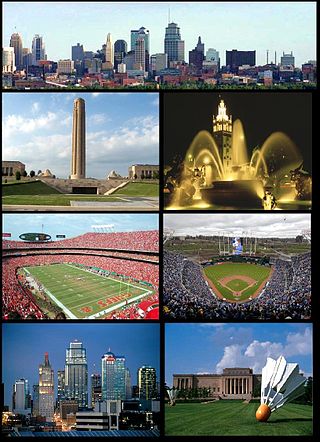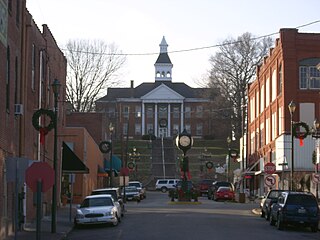In the United States, a metropolitan statistical area (MSA) is a geographical region with a relatively high population density at its core and close economic ties throughout the region. Such regions are not legally incorporated as a city or town would be and are not legal administrative divisions like counties or separate entities such as states. As a result, sometimes the precise definition of a given metropolitan area will vary between sources. The statistical criteria for a standard metropolitan area were defined in 1949 and redefined as a metropolitan statistical area in 1983.

The City of Edgewater is a home rule municipality located in Jefferson County, Colorado, United States. The city population was 5,005 at the 2020 United States Census. Edgewater is surrounded by Denver to the east, Lakewood to the south and west, and Wheat Ridge to the north. The city is a part of the Denver–Aurora–Lakewood, CO Metropolitan Statistical Area and the Front Range Urban Corridor.

The Kansas City metropolitan area is a bi-state metropolitan area anchored by Kansas City, Missouri. Its 14 counties straddle the border between the U.S. states of Missouri and Kansas. With 8,472 square miles (21,940 km2) and a population of more than 2.2 million people, it is the second-largest metropolitan area centered in Missouri and is the largest metropolitan area in Kansas, though Wichita is the largest metropolitan area centered in Kansas. Alongside Kansas City, Missouri, these are the suburbs with populations above 100,000: Overland Park, Kansas; Kansas City, Kansas; Olathe, Kansas; Independence, Missouri; and Lee's Summit, Missouri.

Greater St. Louis is the 21st-largest metropolitan statistical area (MSA) in the United States, the largest in Missouri, and the second-largest in Illinois. Its core city—St. Louis, Missouri—sits in the geographic center of the metro area, on the west bank of the Mississippi River. The river bisects the metro area geographically between Illinois and Missouri, although the latter portion is much more populous. The MSA includes St. Louis County, which is independent of the City of St. Louis; their two populations are generally tabulated separately.

Bismarck–Mandan, colloquially referred to as BisMan, is the metropolitan area composed of Burleigh, Morton, and Oliver counties in the state of North Dakota.

The Omaha metropolitan area, officially known as the Omaha, NE–IA, Metropolitan Statistical Area (MSA), is an urbanized, bi-state metro region in Nebraska and Iowa in the American Midwest, centered on the city of Omaha, Nebraska. The region consists of eight counties, and extends over a large area on both sides of the Missouri River. Covering 4,407 square miles (11,410 km2) and with a population of 967,604 (2020), the Omaha metropolitan area is the most populous in both Nebraska and Iowa, and is the 58th most populous MSA in the United States. The 2003 revision to metropolitan area definitions was accompanied by the creation of micropolitan areas and combined statistical areas. Fremont, in Dodge County, Nebraska, was designated a micropolitan area. The Omaha–Fremont Combined Statistical Area has a population of 1,058,125 . Approximately 1.5 million people reside within the Greater Omaha area, within a 50 mi (80 km) radius of Downtown Omaha.

The Springfield, Missouri, metropolitan area, as defined by the United States Census Bureau, is an area consisting of five counties in southwestern Missouri, anchored by the city of Springfield, the state's third largest city. Other primary population centers in the metro area include Nixa, Ozark, Republic, Bolivar, Marshfield and Willard. Currently, the city limits of Springfield reach the Nixa, and Ozark city limits at the Christian County line on US 160, and US 65 respectively, the city limits of Republic at James River Freeway on the southwest side of the city, and the Strafford city limits on Route 744 on the northeast side of the city.
The following is a set–index article, providing a list of lists, for the cities, towns and villages within the jurisdictional United States. It is divided, alphabetically, according to the state, territory, or district name in which they are located.

The Columbia metropolitan area is the region centered around the City of Columbia in the U.S. state of Missouri. Located in Mid-Missouri, it consists of five counties: Boone, Audrain, Randolph, Cooper, and Howard. The population was estimated at 256,640 in 2017, making it the 4th largest metropolitan area in Missouri. Columbia is home to the University of Missouri, and is Missouri's fourth most-populous and fastest growing city, with an estimated 121,717 residents as of 2017. Other significant cities in the area include Moberly, Mexico, Boonville, Vandalia, Centralia, and Fayette.
The St. Joseph Metropolitan Statistical Area, as defined by the United States Census Bureau, is an area consisting of four counties - three in northwest Missouri and one in northeast Kansas (Doniphan) - anchored by the city of St. Joseph, comprising a total area of 1,673.93 square miles (4,335.5 km2). As of the 2020 census, the MSA had a population of 121,467.
The U.S. State of Illinois currently has 47 statistical areas that have been delineated by the Office of Management and Budget (OMB). On July 21, 2023, the OMB delineated 14 combined statistical areas, 12 metropolitan statistical areas, and 21 micropolitan statistical areas in Illinois. As of 2023, the largest of these is the Chicago-Naperville, IL-IN-WI CSA, comprising the area around Illinois' largest city, Chicago.
The U.S. State of Missouri currently has 31 statistical areas that have been delineated by the Office of Management and Budget (OMB). On March 6, 2020, the OMB delineated six combined statistical areas, seven metropolitan statistical areas, and 18 micropolitan statistical areas in Missouri. As of 2023, the largest of these is the St. Louis-St. Charles-Farmington, MO-IL CSA, comprising the area around St. Louis.

The Jefferson City metropolitan statistical area, as defined by the United States Census Bureau, is an area consisting of four counties – Cole, Callaway, Moniteau, and Osage – in central Missouri anchored by the city of Jefferson City. As of the 2020 census, the MSA had a population of 150,316. The Jefferson City MSA consists of four counties, and borders the Columbia metropolitan area to the north.

The Joplin, Missouri-Kansas, Metropolitan Statistical Area (MSA), as defined by the United States Census Bureau, is an area consisting of Jasper, Newton, and Cherokee counties in southwest Missouri and southeast Kansas anchored by the city of Joplin. The estimated 2023 population of the Joplin, MO-KS (MSA) is 204,787. As of March 2023, The U.S. Census Bureau MSA delineation report added Cherokee County, Kansas to the Joplin, MO MSA making it the Joplin, MO-KS MSA.

The Cape Girardeau–Jackson Metropolitan Statistical Area, as defined by the United States Census Bureau, is an area consisting of two counties in southeastern Missouri and one in southern Illinois with its core in both states. Its largest cities are the cities of Cape Girardeau and Jackson. It was upgraded from a Micropolitan Statistical Area (μSA) to a Metropolitan Statistical Area (MSA) by the Office of Management and Budget on November 20, 2008.
The Fort Madison–Keokuk, IA-IL-MO Micropolitan Statistical Area, as defined by the United States Census Bureau, locally known as the "Tri-State" area, was an area consisting of three counties – one in southeast Iowa, one in northeast Missouri, and one in west central Illinois, anchored by the cities of Fort Madison, Iowa and Keokuk, Iowa. As of the 2010 census, the μSA had a population of 62,105. An estimate by the Census Bureau, as of July 1, 2012, placed the population at 61,477, a decrease of 1.01%. When the 2023 definitions were released this area was dissolved with Lee County, Iowa being included as part of the Burlington–Fort Madison, IA–IL Combined Statistical Area.
Mandalay FM is a radio station that serves the Mandalay metropolitan area, broadcasting on the FM band at a frequency of 87.9 MHz and on the Internet. Now the radio station is also serving 30 miles (48 km) around Taungoo and 60 miles (97 km) around Yangon.
Cedar Glen is an unincorporated community in San Bernardino County, California, United States. This mountain community lies at an elevation of 5403 ft, and is located within the San Bernardino National Forest resort area immediately east of Lake Arrowhead. California State Highway 173 bisects Cedar Glen and passes through Lake Arrowhead.











